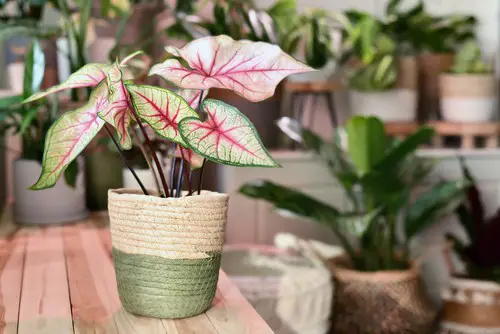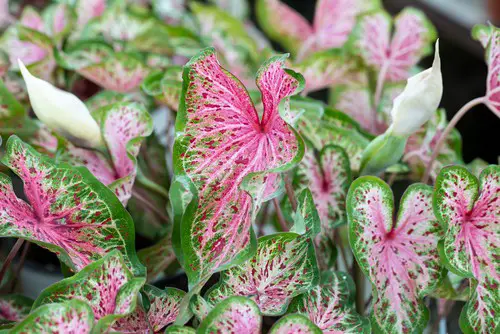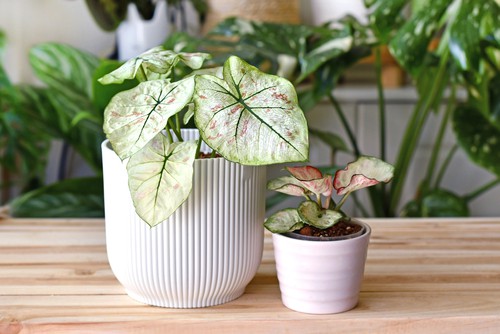When gardeners transplant their elephant ear plants, they expect them to thrive in their new environment. However, sometimes these plants may start to droop after the transplant, causing concern for the gardener.
Understanding the reasons behind an elephant ear plant drooping after transplant can help the gardener address the issue and ensure the plant’s health.
Elephant ear plants are known for their large, showy leaves that resemble the ears of an elephant. These plants thrive in warm, humid environments and require moist soil to grow.
When transplanting an elephant ear plant, it is important to ensure that the plant is not exposed to direct sunlight and that the soil is moist enough to support the plant’s growth. If these conditions are not met, the plant may start to droop, indicating that it is not receiving the proper care.
Addressing drooping issues in an elephant ear plant after transplanting requires a careful assessment of the plant’s environment and care. This may include adjusting the amount of water the plant receives, ensuring that the plant is not exposed to direct sunlight, and checking the quality of the soil.
Additionally, gardeners may need to fertilize the plant or provide it with additional nutrients to support its growth. By addressing these issues, gardeners can help their elephant ear plants thrive in their new environment.
Key Takeaways on Elephant Ear Plant Drooping After Transplant
- Elephant ear plants require warm, humid environments and moist soil to grow.
- Drooping in an elephant ear plant after transplanting may indicate that the plant is not receiving the proper care.
- Addressing drooping issues requires a careful assessment of the plant’s environment and care, including adjusting the amount of water, checking the quality of the soil, and providing additional nutrients.
More posts on this category:
Understanding Elephant Ear Plant

1. Origin and Species
Elephant ear plants are native to Asia and belong to the Araceae family. There are three main species: Colocasia, Alocasia, and Xanthosoma. Colocasia is commonly known as taro and has heart-shaped leaves, while Alocasia has arrow-shaped leaves and Xanthosoma has spear-shaped leaves.
2. Physical Characteristics
Elephant ear plants have large, textured leaves that grow on long stems. The leaves can range in size from a few inches to several feet long, depending on the species. The stem of the plant is also textured and can grow up to several feet tall. The plant produces tubers, which are used for propagation and can be eaten in some cultures.
3. Ideal Conditions
Elephant ear plants thrive in warm, humid environments with moist soil. They prefer partial shade but can tolerate full sunlight if the soil is kept moist. Temperatures between 65°F and 85°F are ideal for growth. The plant is susceptible to root rot if the soil is too wet, and pest infestations can occur if the humidity is too low.
4. Common Diseases and Pests
Elephant ear plants are prone to disease and pest infestations. Root rot can occur if the soil is too wet, and fungal diseases can affect the leaves. Pests such as spider mites, mealybugs, and aphids can also infect the plant. Regular inspection and treatment can prevent these issues.
5. Nutrient Requirements
Elephant ear plants require regular fertilization to maintain healthy growth. Nitrogen is an essential nutrient for the plant, and slow-release fertilizer or aged manure can be used to provide this. Organic materials such as compost or leaf mold can also be added to the soil to improve nutrient content.
Transplanting Elephant Ear Plant

When it comes to transplanting an elephant ear plant, gardeners need to be careful and attentive to ensure the plant’s health. Transplanting can cause root damage and transplant shock, which can lead to drooping leaves and other issues.
In this section, we will discuss the best time for transplanting, tools and materials required, the transplant procedure, and post-transplant care.
Best Time for Transplanting
The best time to transplant an elephant ear plant is during the growing season, either in the spring or early fall. Late spring is ideal as the plant has enough time to establish its root system before the hot summer months.
Transplanting during the summer is not recommended as the plant may struggle to cope with the full sun and high temperatures.
Tools and Materials
Gardeners will need a few tools and materials to transplant an elephant ear plant successfully. These include a knife or shovel to divide the root ball, potting soil, compost, peat moss, perlite, mulch, and stakes to support the plant.
Transplant Procedure
To transplant an elephant ear plant, start by digging a hole that is twice the size of the plant’s root ball. Gently remove the plant from its current pot or container, being careful not to damage the roots.
Divide the root ball if necessary, and place the plant in the new hole. Fill the hole with potting soil mixed with compost, peat moss, and perlite. Add mulch around the base of the plant to retain moisture and suppress weeds. Finally, stake the plant to provide support.
Post-Transplant Care
Proper care and attention are crucial after transplanting an elephant ear plant. Regular watering is essential, but gardeners should avoid overwatering or underwatering the plant.
Establish a watering schedule and ensure the soil maintains adequate moisture and drainage. Pruning may also be necessary to remove damaged or diseased leaves. Stakes should be removed once the plant has established itself in its new location.
Addressing Drooping Issues

1. Causes of Drooping
Elephant ear plants, also known as Colocasia esculenta, can experience drooping after transplant due to various factors. In-ground plants may experience stress due to changes in temperature, heat, or cold temperatures. Standing water around the roots can also cause drooping, as it can lead to root rot and disease.
Nutrient deficiency can cause yellowing leaves and stunted growth, which may also cause the leaves to droop. Underwatering or overwatering can also cause the leaves to droop, as can inadequate lighting.
2. Solutions for Drooping
To address drooping issues in elephant ear plants, it is important to first identify the underlying cause. If the issue is due to underwatering, the plant should be watered more frequently.
If overwatering is the issue, the plant should be watered less frequently and the soil should be allowed to dry out before watering again. If the issue is due to inadequate lighting, the plant should be moved to a brighter location.
Nutrient deficiencies can be addressed by fertilizing the plant with a balanced fertilizer. If the plant is experiencing stress due to temperature changes, it should be moved to a more suitable location. If standing water is the issue, the plant should be moved to a location with better drainage.
3. Preventing Future Drooping
To prevent future drooping issues, it is important to ensure that the plant is in a suitable location with adequate lighting, proper soil, and good drainage. The plant should be watered regularly, but not overwatered. The humidity level should also be maintained at an appropriate level to prevent stress.
4. Monitoring Plant Health
To monitor the health of the plant, it is important to regularly check the leaves, stem, and root system for any signs of blemish or disease.
The plant should also be regularly fertilized to ensure that it has the necessary nutrients to thrive. If the plant is invasive, it may need to be rejuvenated by dividing the root system and planting in sterile soil.
Frequently Asked Questions

Why is my elephant ear plant drooping after transplanting?
Elephant ear plants may droop after transplanting due to stress. Transplant shock can cause the plant to lose water through its leaves faster than it can absorb it from the soil.
This can result in drooping leaves. Additionally, the roots may not have had enough time to establish themselves in the new soil, which can cause the plant to droop.
How do I prevent my elephant ear plant from drooping after transplanting?
To prevent your elephant ear plant from drooping after transplanting, make sure to water it thoroughly and regularly. Keep the soil moist, but not waterlogged.
Avoid over-fertilizing and over-watering, as this can stress the plant. Additionally, make sure to transplant the plant during the appropriate season when the plant is dormant.
Do elephant ear plants transplant well?
Yes, elephant ear plants can transplant well if done correctly. It is important to transplant the plant during the appropriate season when the plant is dormant. Additionally, make sure to use well-draining soil and water the plant regularly after transplanting.
Are drooping leaves normal after transplanting an elephant ear plant?
Drooping leaves are common after transplanting an elephant ear plant. The plant may be experiencing transplant shock, which can cause the leaves to droop. However, if the drooping persists for an extended period of time, it may be a sign of a more serious issue.
How can I stake my elephant ear plant to prevent drooping?
To stake your elephant ear plant, gently insert a stake into the soil beside the plant. Then, tie the stem of the plant to the stake using a soft, flexible material such as twine or plant ties. Be sure not to tie the stem too tightly, as this can damage the plant.
What causes elephant ear stems to bend or droop after transplanting?
Elephant ear stems may bend or droop after transplanting due to transplant shock. This can cause the plant to lose water through its leaves faster than it can absorb it from the soil, resulting in drooping stems.
Additionally, the roots may not have had enough time to establish themselves in the new soil, which can cause the stems to bend or droop.

Hey, I’m Lisa and I’ve been an avid gardener for over 30 years. I love writing, talking and living in the garden! Feel free to connect with me on my socials below

